Toyota Recall Analysis: Problem Solving and Strategic Approaches
VerifiedAdded on 2022/09/06
|21
|4579
|27
Report
AI Summary
This report analyzes the Toyota recall crisis, examining the problems faced by the company, the approaches used to solve them, and the impact on stakeholders. The report begins with an introduction to the Toyota Motor Corporation, outlining the nature of the recall, which involved faulty acceleration pedals and floor mats leading to accidents and fatalities. It then discusses the approaches Toyota implemented, including timing and preparation, communication strategies, and leadership decisions, to address the crisis. A critical analysis of these approaches is provided, highlighting both strengths and weaknesses. The report also suggests alternative approaches for improvement, such as cause-mapping and non-rational decision-making models, to enhance crisis management. Finally, the report includes a stock market analysis, examining the reactions of investments and share price trends during the crisis, and concludes with recommendations for future crisis management strategies.
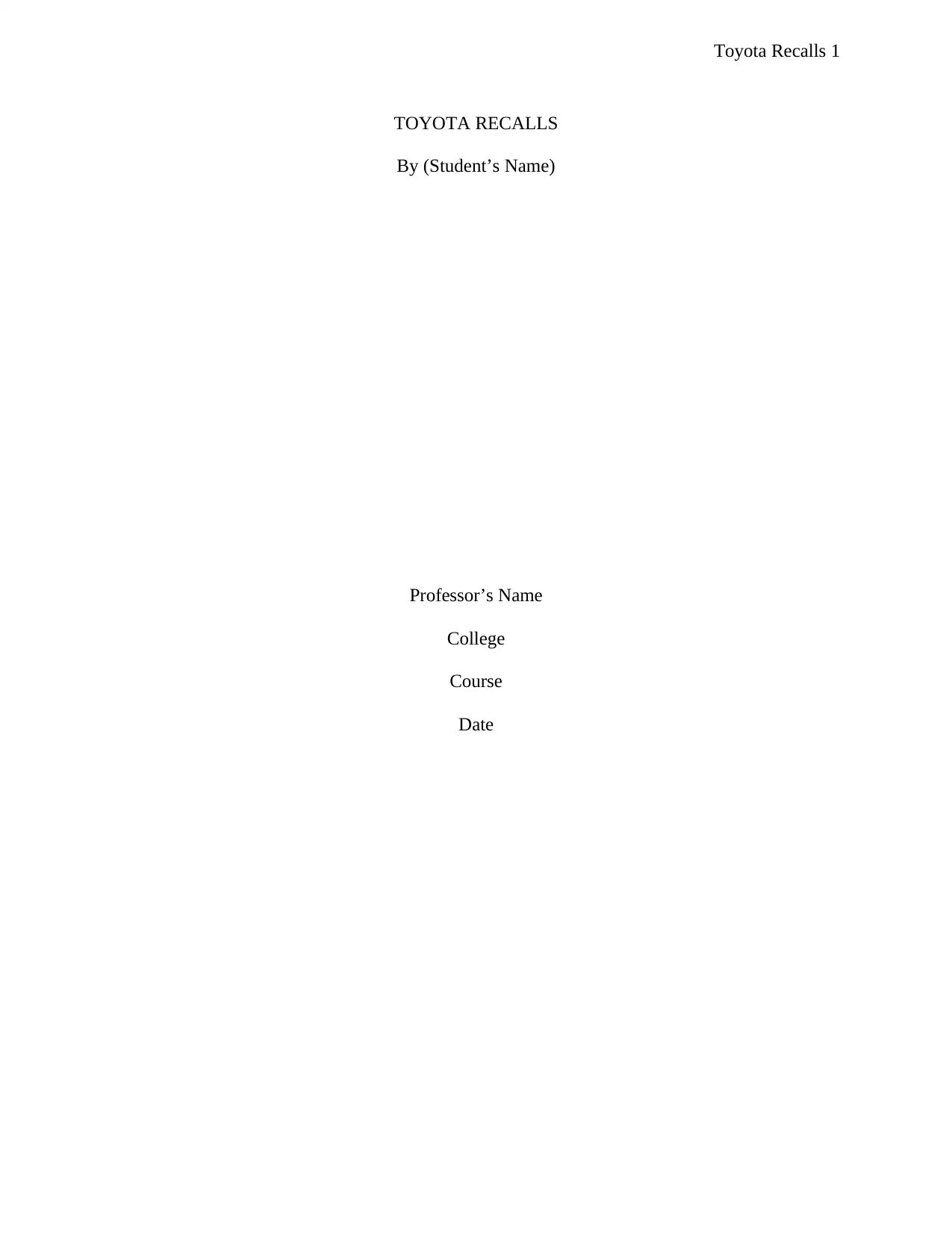
Toyota Recalls 1
TOYOTA RECALLS
By (Student’s Name)
Professor’s Name
College
Course
Date
TOYOTA RECALLS
By (Student’s Name)
Professor’s Name
College
Course
Date
Paraphrase This Document
Need a fresh take? Get an instant paraphrase of this document with our AI Paraphraser

Toyota Recalls 2
TOYOTA RECALLS
Table of Contents
1.0 Introduction................................................................................................................................3
1.1. Purpose of Report..................................................................................................................3
2.0. Problem Solving by the Company............................................................................................7
2.1 Approaches and Methods Implemented to Solve the Problem..............................................7
2.2 Critical Analysis of Approaches Used by Toyota to Solve the Problem...............................8
3.0 Suggestions on Other Approaches for Improvement...............................................................10
3.1 Improvements Suggested in the Approach Used.................................................................10
3.2 Other Available Approaches................................................................................................14
3.3. The Best Approach..............................................................................................................15
4.0 Stock Market Analysis.............................................................................................................16
4.1 Reactions of Investments to Problem and Solution.............................................................16
4.2 Trend Analysis of Share Price during the Period.................................................................16
5.0 Conclusion...............................................................................................................................18
6.0 Recommendations....................................................................................................................19
7.0 References................................................................................................................................20
TOYOTA RECALLS
Table of Contents
1.0 Introduction................................................................................................................................3
1.1. Purpose of Report..................................................................................................................3
2.0. Problem Solving by the Company............................................................................................7
2.1 Approaches and Methods Implemented to Solve the Problem..............................................7
2.2 Critical Analysis of Approaches Used by Toyota to Solve the Problem...............................8
3.0 Suggestions on Other Approaches for Improvement...............................................................10
3.1 Improvements Suggested in the Approach Used.................................................................10
3.2 Other Available Approaches................................................................................................14
3.3. The Best Approach..............................................................................................................15
4.0 Stock Market Analysis.............................................................................................................16
4.1 Reactions of Investments to Problem and Solution.............................................................16
4.2 Trend Analysis of Share Price during the Period.................................................................16
5.0 Conclusion...............................................................................................................................18
6.0 Recommendations....................................................................................................................19
7.0 References................................................................................................................................20
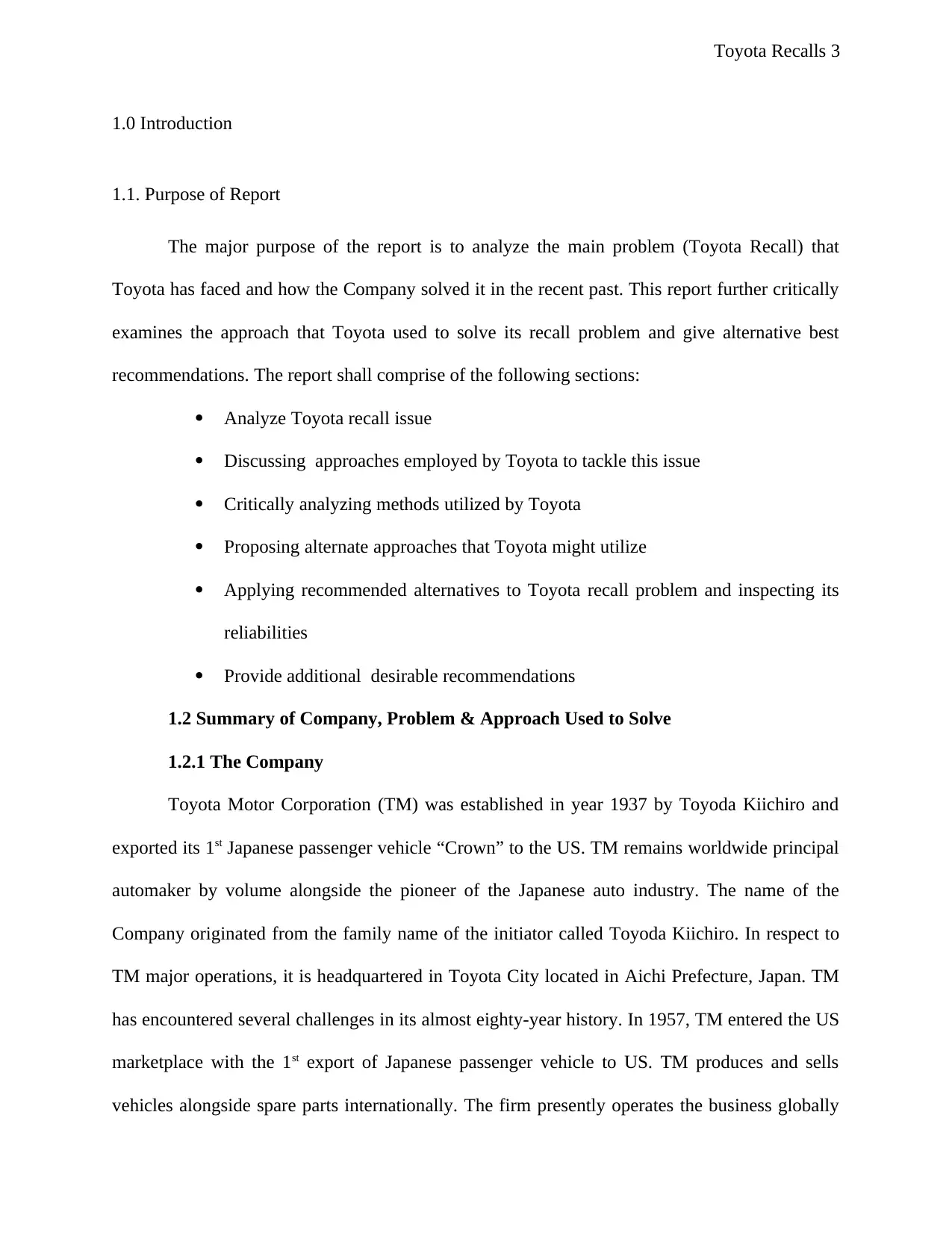
Toyota Recalls 3
1.0 Introduction
1.1. Purpose of Report
The major purpose of the report is to analyze the main problem (Toyota Recall) that
Toyota has faced and how the Company solved it in the recent past. This report further critically
examines the approach that Toyota used to solve its recall problem and give alternative best
recommendations. The report shall comprise of the following sections:
Analyze Toyota recall issue
Discussing approaches employed by Toyota to tackle this issue
Critically analyzing methods utilized by Toyota
Proposing alternate approaches that Toyota might utilize
Applying recommended alternatives to Toyota recall problem and inspecting its
reliabilities
Provide additional desirable recommendations
1.2 Summary of Company, Problem & Approach Used to Solve
1.2.1 The Company
Toyota Motor Corporation (TM) was established in year 1937 by Toyoda Kiichiro and
exported its 1st Japanese passenger vehicle “Crown” to the US. TM remains worldwide principal
automaker by volume alongside the pioneer of the Japanese auto industry. The name of the
Company originated from the family name of the initiator called Toyoda Kiichiro. In respect to
TM major operations, it is headquartered in Toyota City located in Aichi Prefecture, Japan. TM
has encountered several challenges in its almost eighty-year history. In 1957, TM entered the US
marketplace with the 1st export of Japanese passenger vehicle to US. TM produces and sells
vehicles alongside spare parts internationally. The firm presently operates the business globally
1.0 Introduction
1.1. Purpose of Report
The major purpose of the report is to analyze the main problem (Toyota Recall) that
Toyota has faced and how the Company solved it in the recent past. This report further critically
examines the approach that Toyota used to solve its recall problem and give alternative best
recommendations. The report shall comprise of the following sections:
Analyze Toyota recall issue
Discussing approaches employed by Toyota to tackle this issue
Critically analyzing methods utilized by Toyota
Proposing alternate approaches that Toyota might utilize
Applying recommended alternatives to Toyota recall problem and inspecting its
reliabilities
Provide additional desirable recommendations
1.2 Summary of Company, Problem & Approach Used to Solve
1.2.1 The Company
Toyota Motor Corporation (TM) was established in year 1937 by Toyoda Kiichiro and
exported its 1st Japanese passenger vehicle “Crown” to the US. TM remains worldwide principal
automaker by volume alongside the pioneer of the Japanese auto industry. The name of the
Company originated from the family name of the initiator called Toyoda Kiichiro. In respect to
TM major operations, it is headquartered in Toyota City located in Aichi Prefecture, Japan. TM
has encountered several challenges in its almost eighty-year history. In 1957, TM entered the US
marketplace with the 1st export of Japanese passenger vehicle to US. TM produces and sells
vehicles alongside spare parts internationally. The firm presently operates the business globally
⊘ This is a preview!⊘
Do you want full access?
Subscribe today to unlock all pages.

Trusted by 1+ million students worldwide
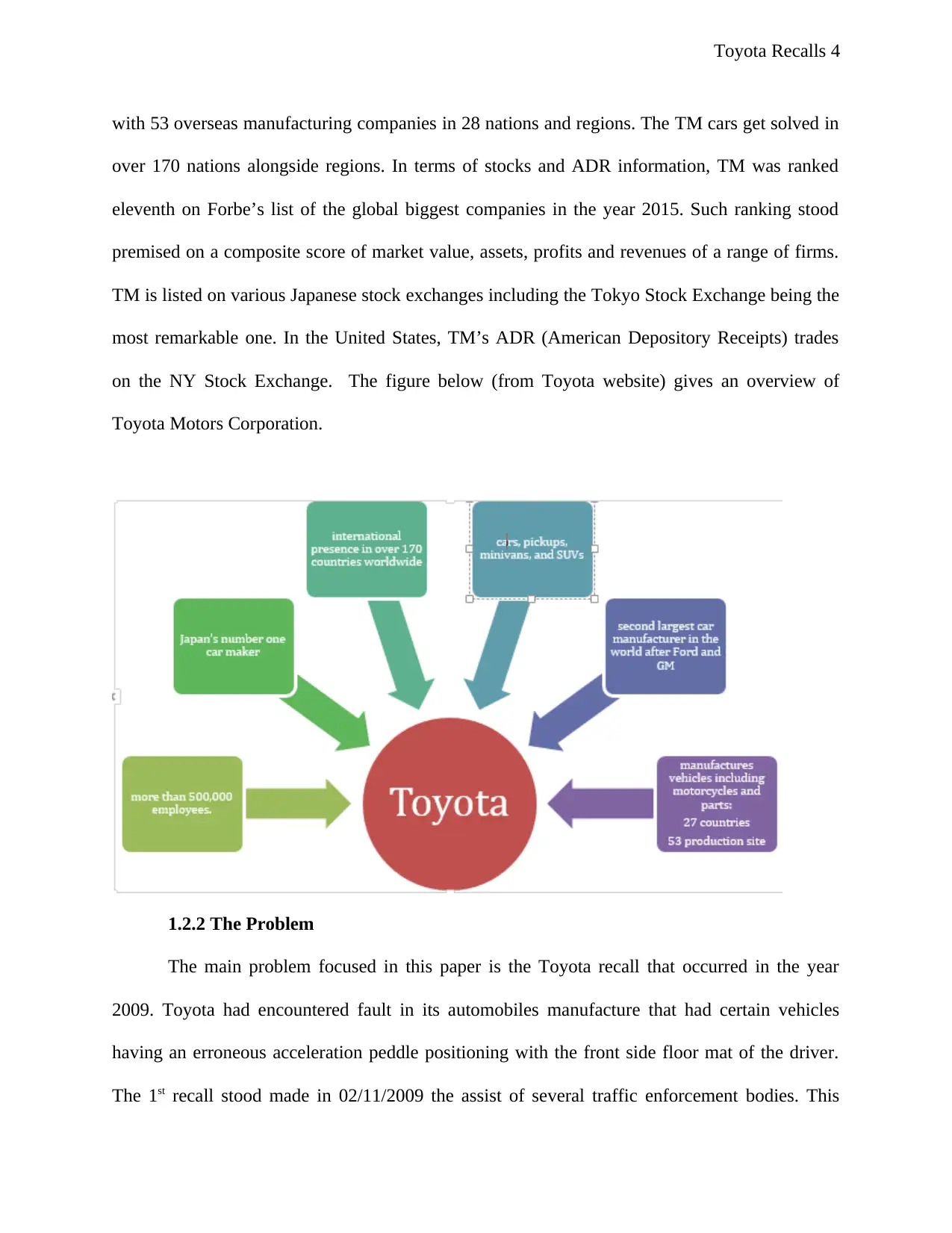
Toyota Recalls 4
with 53 overseas manufacturing companies in 28 nations and regions. The TM cars get solved in
over 170 nations alongside regions. In terms of stocks and ADR information, TM was ranked
eleventh on Forbe’s list of the global biggest companies in the year 2015. Such ranking stood
premised on a composite score of market value, assets, profits and revenues of a range of firms.
TM is listed on various Japanese stock exchanges including the Tokyo Stock Exchange being the
most remarkable one. In the United States, TM’s ADR (American Depository Receipts) trades
on the NY Stock Exchange. The figure below (from Toyota website) gives an overview of
Toyota Motors Corporation.
1.2.2 The Problem
The main problem focused in this paper is the Toyota recall that occurred in the year
2009. Toyota had encountered fault in its automobiles manufacture that had certain vehicles
having an erroneous acceleration peddle positioning with the front side floor mat of the driver.
The 1st recall stood made in 02/11/2009 the assist of several traffic enforcement bodies. This
with 53 overseas manufacturing companies in 28 nations and regions. The TM cars get solved in
over 170 nations alongside regions. In terms of stocks and ADR information, TM was ranked
eleventh on Forbe’s list of the global biggest companies in the year 2015. Such ranking stood
premised on a composite score of market value, assets, profits and revenues of a range of firms.
TM is listed on various Japanese stock exchanges including the Tokyo Stock Exchange being the
most remarkable one. In the United States, TM’s ADR (American Depository Receipts) trades
on the NY Stock Exchange. The figure below (from Toyota website) gives an overview of
Toyota Motors Corporation.
1.2.2 The Problem
The main problem focused in this paper is the Toyota recall that occurred in the year
2009. Toyota had encountered fault in its automobiles manufacture that had certain vehicles
having an erroneous acceleration peddle positioning with the front side floor mat of the driver.
The 1st recall stood made in 02/11/2009 the assist of several traffic enforcement bodies. This
Paraphrase This Document
Need a fresh take? Get an instant paraphrase of this document with our AI Paraphraser
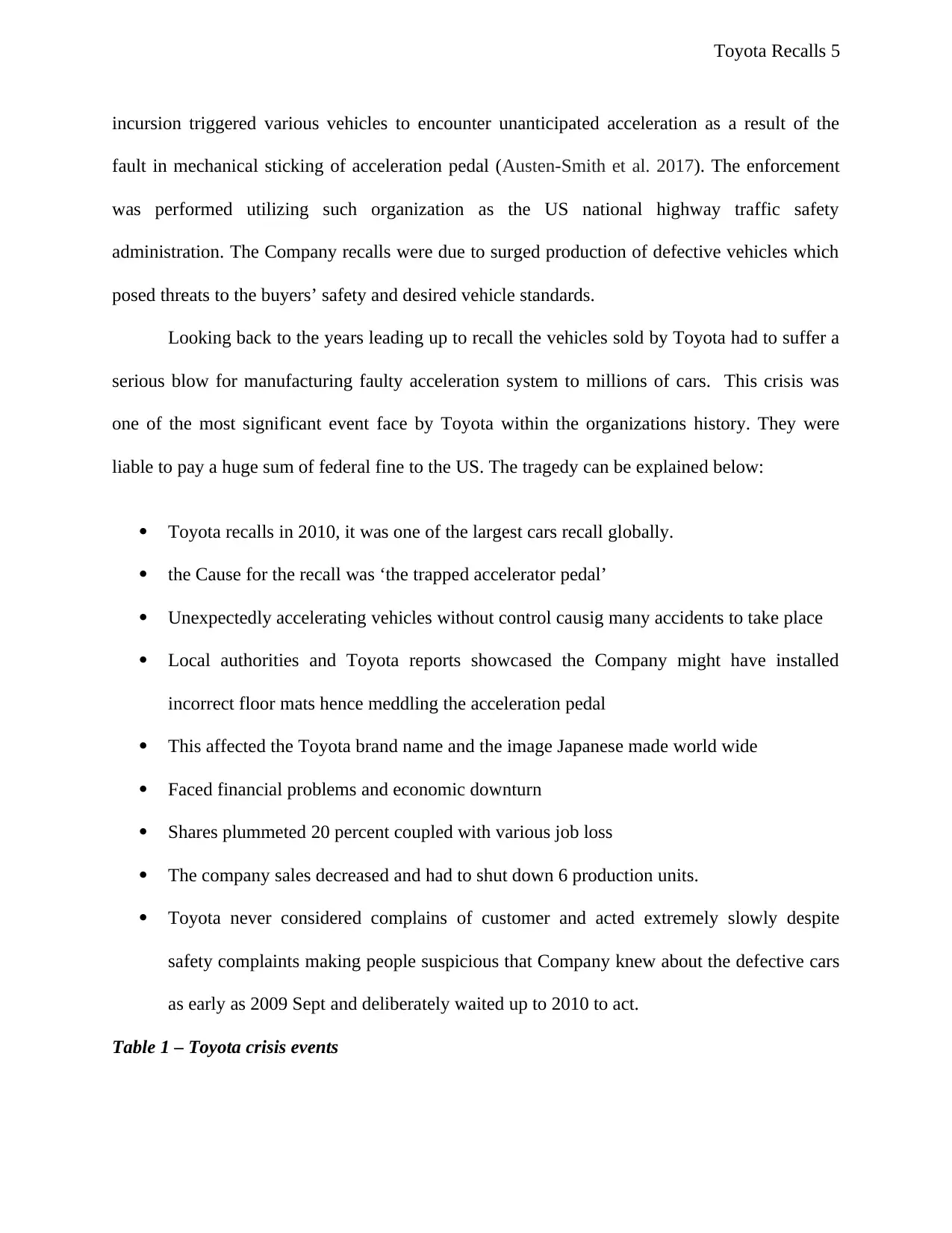
Toyota Recalls 5
incursion triggered various vehicles to encounter unanticipated acceleration as a result of the
fault in mechanical sticking of acceleration pedal (Austen-Smith et al. 2017). The enforcement
was performed utilizing such organization as the US national highway traffic safety
administration. The Company recalls were due to surged production of defective vehicles which
posed threats to the buyers’ safety and desired vehicle standards.
Looking back to the years leading up to recall the vehicles sold by Toyota had to suffer a
serious blow for manufacturing faulty acceleration system to millions of cars. This crisis was
one of the most significant event face by Toyota within the organizations history. They were
liable to pay a huge sum of federal fine to the US. The tragedy can be explained below:
Toyota recalls in 2010, it was one of the largest cars recall globally.
the Cause for the recall was ‘the trapped accelerator pedal’
Unexpectedly accelerating vehicles without control causig many accidents to take place
Local authorities and Toyota reports showcased the Company might have installed
incorrect floor mats hence meddling the acceleration pedal
This affected the Toyota brand name and the image Japanese made world wide
Faced financial problems and economic downturn
Shares plummeted 20 percent coupled with various job loss
The company sales decreased and had to shut down 6 production units.
Toyota never considered complains of customer and acted extremely slowly despite
safety complaints making people suspicious that Company knew about the defective cars
as early as 2009 Sept and deliberately waited up to 2010 to act.
Table 1 – Toyota crisis events
incursion triggered various vehicles to encounter unanticipated acceleration as a result of the
fault in mechanical sticking of acceleration pedal (Austen-Smith et al. 2017). The enforcement
was performed utilizing such organization as the US national highway traffic safety
administration. The Company recalls were due to surged production of defective vehicles which
posed threats to the buyers’ safety and desired vehicle standards.
Looking back to the years leading up to recall the vehicles sold by Toyota had to suffer a
serious blow for manufacturing faulty acceleration system to millions of cars. This crisis was
one of the most significant event face by Toyota within the organizations history. They were
liable to pay a huge sum of federal fine to the US. The tragedy can be explained below:
Toyota recalls in 2010, it was one of the largest cars recall globally.
the Cause for the recall was ‘the trapped accelerator pedal’
Unexpectedly accelerating vehicles without control causig many accidents to take place
Local authorities and Toyota reports showcased the Company might have installed
incorrect floor mats hence meddling the acceleration pedal
This affected the Toyota brand name and the image Japanese made world wide
Faced financial problems and economic downturn
Shares plummeted 20 percent coupled with various job loss
The company sales decreased and had to shut down 6 production units.
Toyota never considered complains of customer and acted extremely slowly despite
safety complaints making people suspicious that Company knew about the defective cars
as early as 2009 Sept and deliberately waited up to 2010 to act.
Table 1 – Toyota crisis events

Toyota Recalls 6
1.2.3 Impacted Stakeholders of Toyota Recalls
impact on
stakeholders
employee
Customer
Shareholders
community
Government
Toyota
Dealers
1.2.3 Impacted Stakeholders of Toyota Recalls
impact on
stakeholders
employee
Customer
Shareholders
community
Government
Toyota
Dealers
⊘ This is a preview!⊘
Do you want full access?
Subscribe today to unlock all pages.

Trusted by 1+ million students worldwide

Toyota Recalls 7
Community: The community was negatively imapcted by the accidents and deaths of the
people due to the defective vehicles.
Customers- Life fatalities, loss of investments on vechile, brand trust
Employee – loss of jobs, Downturn of saleries, Trust breakdown of management relations
Government – The government was negatively impacted as a result of the lost taxation
revenue arising from the loss of sales and reduced share prices.
Shareholders-The shareholders were negatively affected due to the lowest prices of
shares which meant least dividend payout
Toyota dealers /distrib-The dealers and distributors were significnatly negatively affected
by the recalls as a result of low sales and increased expenses following the recalls as they
lost not only revenue but also income.
2.0. Problem Solving by the Company
2.1 Approaches and Methods Implemented to Solve the Problem
Timing and preparation: The issues of recalls due to defective cars have a potential of
being a widespread concern in case of no urgent address from the start. Evading and expecting
business crises needs various steps including threat recognition, and prioritizing, resource
mobilization. Toyota must adhere to such three main phases to effective management of crises.
Toyota never tackled the recall problem at the start in the year 2007 and hence missed the
opportunity for damage reduction. Tackling the challenge at the beginning remains efficient and
moral. Toyota only emphasized on clients without addressing the needs of all stakeholders. The
management of stakeholders and communication lacked the desired preferences. The Company
ushered a novel process of handling crises through SMART business framework to rapidly speak
Community: The community was negatively imapcted by the accidents and deaths of the
people due to the defective vehicles.
Customers- Life fatalities, loss of investments on vechile, brand trust
Employee – loss of jobs, Downturn of saleries, Trust breakdown of management relations
Government – The government was negatively impacted as a result of the lost taxation
revenue arising from the loss of sales and reduced share prices.
Shareholders-The shareholders were negatively affected due to the lowest prices of
shares which meant least dividend payout
Toyota dealers /distrib-The dealers and distributors were significnatly negatively affected
by the recalls as a result of low sales and increased expenses following the recalls as they
lost not only revenue but also income.
2.0. Problem Solving by the Company
2.1 Approaches and Methods Implemented to Solve the Problem
Timing and preparation: The issues of recalls due to defective cars have a potential of
being a widespread concern in case of no urgent address from the start. Evading and expecting
business crises needs various steps including threat recognition, and prioritizing, resource
mobilization. Toyota must adhere to such three main phases to effective management of crises.
Toyota never tackled the recall problem at the start in the year 2007 and hence missed the
opportunity for damage reduction. Tackling the challenge at the beginning remains efficient and
moral. Toyota only emphasized on clients without addressing the needs of all stakeholders. The
management of stakeholders and communication lacked the desired preferences. The Company
ushered a novel process of handling crises through SMART business framework to rapidly speak
Paraphrase This Document
Need a fresh take? Get an instant paraphrase of this document with our AI Paraphraser
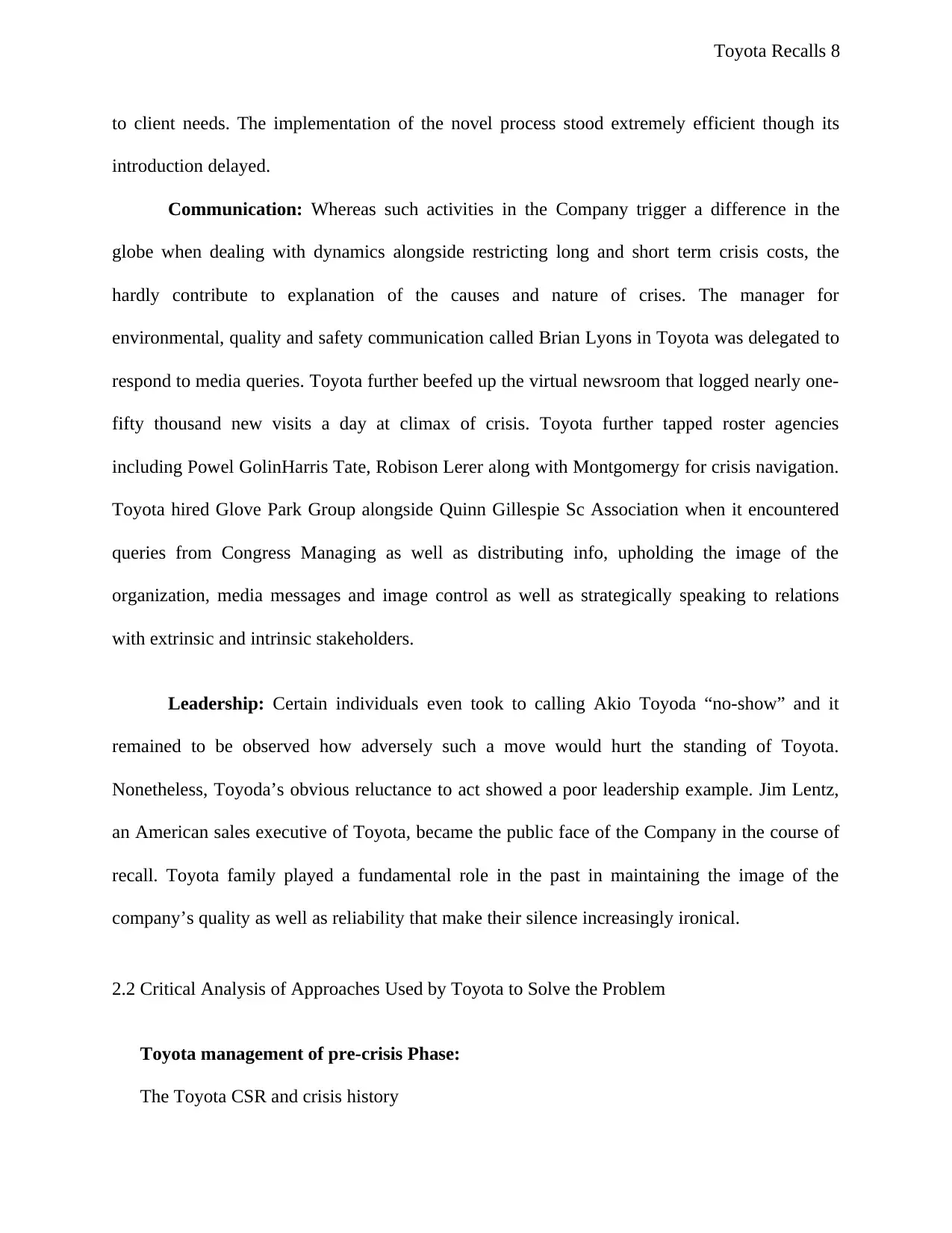
Toyota Recalls 8
to client needs. The implementation of the novel process stood extremely efficient though its
introduction delayed.
Communication: Whereas such activities in the Company trigger a difference in the
globe when dealing with dynamics alongside restricting long and short term crisis costs, the
hardly contribute to explanation of the causes and nature of crises. The manager for
environmental, quality and safety communication called Brian Lyons in Toyota was delegated to
respond to media queries. Toyota further beefed up the virtual newsroom that logged nearly one-
fifty thousand new visits a day at climax of crisis. Toyota further tapped roster agencies
including Powel GolinHarris Tate, Robison Lerer along with Montgomergy for crisis navigation.
Toyota hired Glove Park Group alongside Quinn Gillespie Sc Association when it encountered
queries from Congress Managing as well as distributing info, upholding the image of the
organization, media messages and image control as well as strategically speaking to relations
with extrinsic and intrinsic stakeholders.
Leadership: Certain individuals even took to calling Akio Toyoda “no-show” and it
remained to be observed how adversely such a move would hurt the standing of Toyota.
Nonetheless, Toyoda’s obvious reluctance to act showed a poor leadership example. Jim Lentz,
an American sales executive of Toyota, became the public face of the Company in the course of
recall. Toyota family played a fundamental role in the past in maintaining the image of the
company’s quality as well as reliability that make their silence increasingly ironical.
2.2 Critical Analysis of Approaches Used by Toyota to Solve the Problem
Toyota management of pre-crisis Phase:
The Toyota CSR and crisis history
to client needs. The implementation of the novel process stood extremely efficient though its
introduction delayed.
Communication: Whereas such activities in the Company trigger a difference in the
globe when dealing with dynamics alongside restricting long and short term crisis costs, the
hardly contribute to explanation of the causes and nature of crises. The manager for
environmental, quality and safety communication called Brian Lyons in Toyota was delegated to
respond to media queries. Toyota further beefed up the virtual newsroom that logged nearly one-
fifty thousand new visits a day at climax of crisis. Toyota further tapped roster agencies
including Powel GolinHarris Tate, Robison Lerer along with Montgomergy for crisis navigation.
Toyota hired Glove Park Group alongside Quinn Gillespie Sc Association when it encountered
queries from Congress Managing as well as distributing info, upholding the image of the
organization, media messages and image control as well as strategically speaking to relations
with extrinsic and intrinsic stakeholders.
Leadership: Certain individuals even took to calling Akio Toyoda “no-show” and it
remained to be observed how adversely such a move would hurt the standing of Toyota.
Nonetheless, Toyoda’s obvious reluctance to act showed a poor leadership example. Jim Lentz,
an American sales executive of Toyota, became the public face of the Company in the course of
recall. Toyota family played a fundamental role in the past in maintaining the image of the
company’s quality as well as reliability that make their silence increasingly ironical.
2.2 Critical Analysis of Approaches Used by Toyota to Solve the Problem
Toyota management of pre-crisis Phase:
The Toyota CSR and crisis history
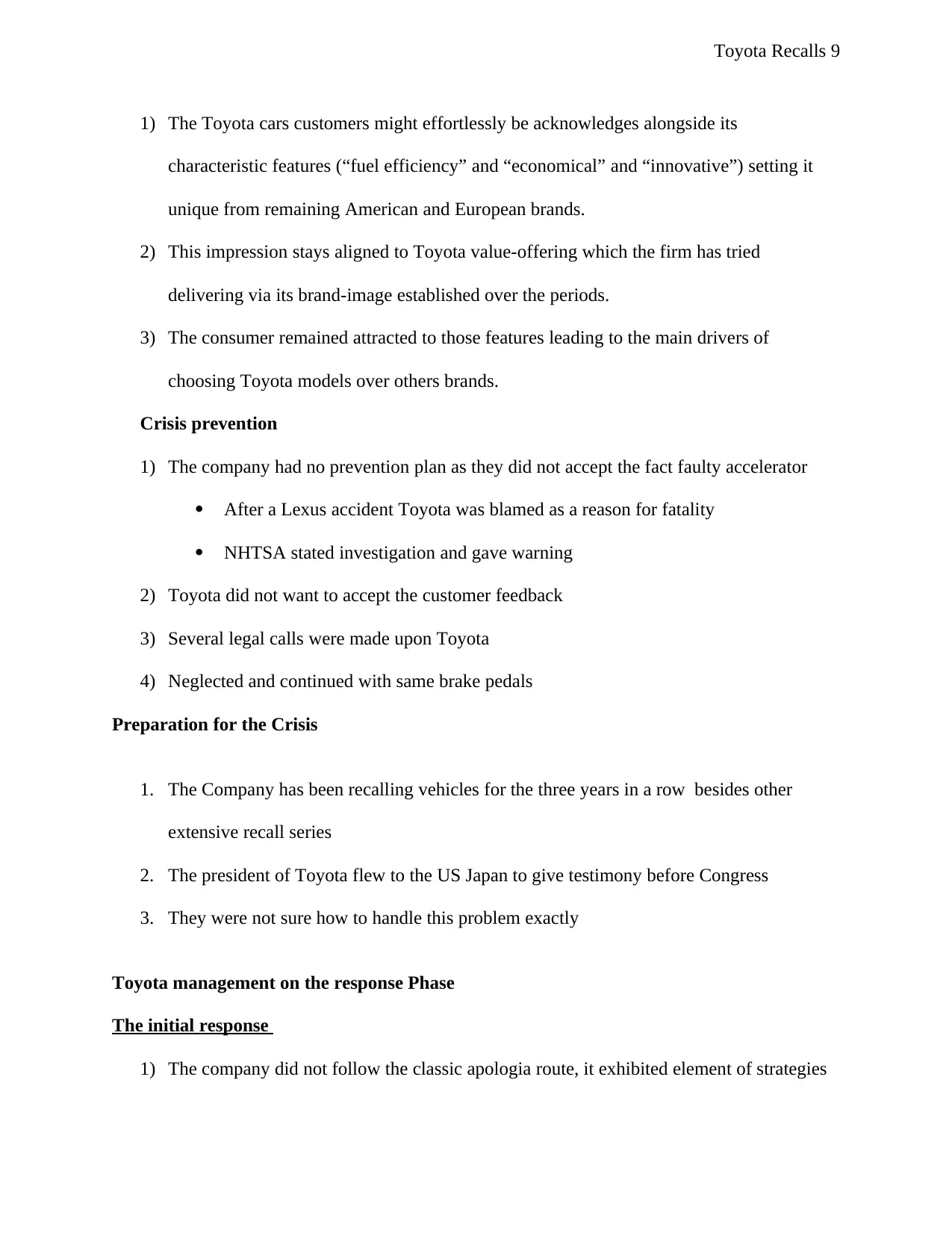
Toyota Recalls 9
1) The Toyota cars customers might effortlessly be acknowledges alongside its
characteristic features (“fuel efficiency” and “economical” and “innovative”) setting it
unique from remaining American and European brands.
2) This impression stays aligned to Toyota value-offering which the firm has tried
delivering via its brand-image established over the periods.
3) The consumer remained attracted to those features leading to the main drivers of
choosing Toyota models over others brands.
Crisis prevention
1) The company had no prevention plan as they did not accept the fact faulty accelerator
After a Lexus accident Toyota was blamed as a reason for fatality
NHTSA stated investigation and gave warning
2) Toyota did not want to accept the customer feedback
3) Several legal calls were made upon Toyota
4) Neglected and continued with same brake pedals
Preparation for the Crisis
1. The Company has been recalling vehicles for the three years in a row besides other
extensive recall series
2. The president of Toyota flew to the US Japan to give testimony before Congress
3. They were not sure how to handle this problem exactly
Toyota management on the response Phase
The initial response
1) The company did not follow the classic apologia route, it exhibited element of strategies
1) The Toyota cars customers might effortlessly be acknowledges alongside its
characteristic features (“fuel efficiency” and “economical” and “innovative”) setting it
unique from remaining American and European brands.
2) This impression stays aligned to Toyota value-offering which the firm has tried
delivering via its brand-image established over the periods.
3) The consumer remained attracted to those features leading to the main drivers of
choosing Toyota models over others brands.
Crisis prevention
1) The company had no prevention plan as they did not accept the fact faulty accelerator
After a Lexus accident Toyota was blamed as a reason for fatality
NHTSA stated investigation and gave warning
2) Toyota did not want to accept the customer feedback
3) Several legal calls were made upon Toyota
4) Neglected and continued with same brake pedals
Preparation for the Crisis
1. The Company has been recalling vehicles for the three years in a row besides other
extensive recall series
2. The president of Toyota flew to the US Japan to give testimony before Congress
3. They were not sure how to handle this problem exactly
Toyota management on the response Phase
The initial response
1) The company did not follow the classic apologia route, it exhibited element of strategies
⊘ This is a preview!⊘
Do you want full access?
Subscribe today to unlock all pages.

Trusted by 1+ million students worldwide

Toyota Recalls 10
2) Toyota was not reacting and was ignoring initial reports which mentioned the problems
associated with its other brands
3) After two weeks of delay without Toyotas inaction was pilloried in international media
4) Toyota CEO AKIO TOYADO, in a press conference and subsequently in testimony in
congress apologised for and acknowledged four precious lives had been lost
Reputational repair and Behavioural intentions
1) Dealerships remain operational for extended hours, TV campaigns reiterated firm quality
performance record of Toyota, and outright apologies blended with devotion to fixing
things remain certain damage control approaches undertaken.
2) The Company employed the use of every form of media for communicating the actions
and restored audience trusts.
3) Utilized ads for Toyota advantages alongside humanized organization emphasizing on
the value of present consumer and effective utilization of a range of cars to show side of
Toyota stories
Toyota management of the post crisis management
1) At the macro-cadre, Toyota is anticipated to suffer certain loses in reputational capital for
these recalls.
2) Enables its staff members to directly communicate with its stakeholders.
3.0 Suggestions on Other Approaches for Improvement
3.1 Improvements Suggested in the Approach Used
Overall Approach (Non-Rational Method): The acknowledgment that non-rational
decision-making makes it increasingly difficult for individuals to arrive at informed choices via
2) Toyota was not reacting and was ignoring initial reports which mentioned the problems
associated with its other brands
3) After two weeks of delay without Toyotas inaction was pilloried in international media
4) Toyota CEO AKIO TOYADO, in a press conference and subsequently in testimony in
congress apologised for and acknowledged four precious lives had been lost
Reputational repair and Behavioural intentions
1) Dealerships remain operational for extended hours, TV campaigns reiterated firm quality
performance record of Toyota, and outright apologies blended with devotion to fixing
things remain certain damage control approaches undertaken.
2) The Company employed the use of every form of media for communicating the actions
and restored audience trusts.
3) Utilized ads for Toyota advantages alongside humanized organization emphasizing on
the value of present consumer and effective utilization of a range of cars to show side of
Toyota stories
Toyota management of the post crisis management
1) At the macro-cadre, Toyota is anticipated to suffer certain loses in reputational capital for
these recalls.
2) Enables its staff members to directly communicate with its stakeholders.
3.0 Suggestions on Other Approaches for Improvement
3.1 Improvements Suggested in the Approach Used
Overall Approach (Non-Rational Method): The acknowledgment that non-rational
decision-making makes it increasingly difficult for individuals to arrive at informed choices via
Paraphrase This Document
Need a fresh take? Get an instant paraphrase of this document with our AI Paraphraser

Toyota Recalls 11
assumption that decision-making process lacks relevant satisfactory data and that decision-
making is never certain. Another essential lesson is that the need for considering participants,
problems, solutions and choice opportunities at all times when making a decision. This is based
on the realization that incomplete information culminates in misleading decision-making
process. Consequently, for Toyota to make right and informed decisions and the need of
sufficient info, cause-mapping method of root causes analysis remain increasingly helpful in the
identification of the crisis. The Toyota should thus use the cause-mapping as shown below:
assumption that decision-making process lacks relevant satisfactory data and that decision-
making is never certain. Another essential lesson is that the need for considering participants,
problems, solutions and choice opportunities at all times when making a decision. This is based
on the realization that incomplete information culminates in misleading decision-making
process. Consequently, for Toyota to make right and informed decisions and the need of
sufficient info, cause-mapping method of root causes analysis remain increasingly helpful in the
identification of the crisis. The Toyota should thus use the cause-mapping as shown below:
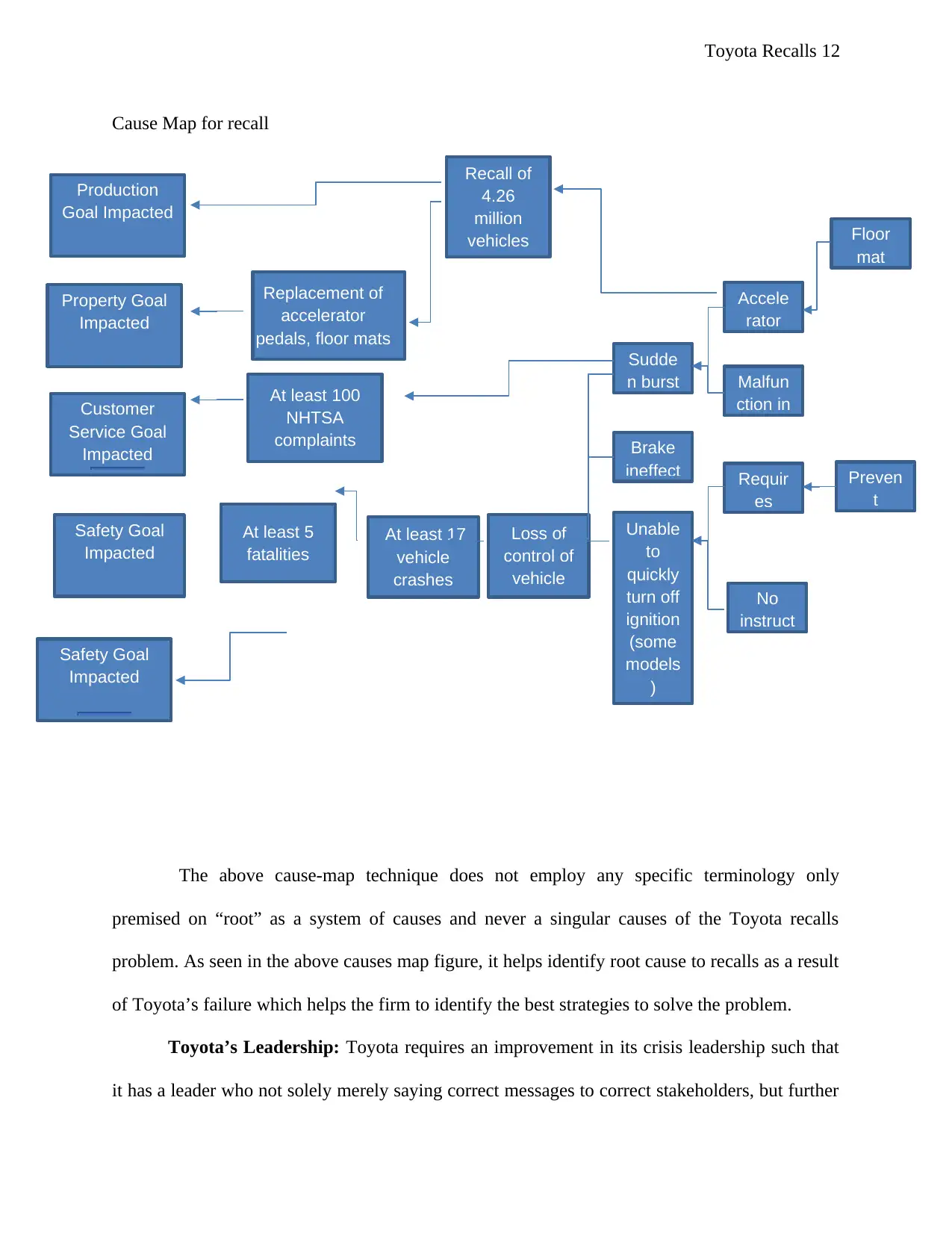
Toyota Recalls 12
Cause Map for recall
The above cause-map technique does not employ any specific terminology only
premised on “root” as a system of causes and never a singular causes of the Toyota recalls
problem. As seen in the above causes map figure, it helps identify root cause to recalls as a result
of Toyota’s failure which helps the firm to identify the best strategies to solve the problem.
Toyota’s Leadership: Toyota requires an improvement in its crisis leadership such that
it has a leader who not solely merely saying correct messages to correct stakeholders, but further
Customer
Service Goal
Impacted
Replacement of
accelerator
pedals, floor mats
At least 100
NHTSA
complaints
At least 5
fatalities
At least 17
vehicle
crashes
Recall of
4.26
million
vehicles
Loss of
control of
vehicle
No
instruct
Brake
ineffect
Sudde
n burst
Requir
es
Malfun
ction in
Accele
rator
Preven
t
Floor
mat
Unable
to
quickly
turn off
ignition
(some
models
)
Safety Goal
Impacted
Safety Goal
Impacted
Property Goal
Impacted
Production
Goal Impacted
Cause Map for recall
The above cause-map technique does not employ any specific terminology only
premised on “root” as a system of causes and never a singular causes of the Toyota recalls
problem. As seen in the above causes map figure, it helps identify root cause to recalls as a result
of Toyota’s failure which helps the firm to identify the best strategies to solve the problem.
Toyota’s Leadership: Toyota requires an improvement in its crisis leadership such that
it has a leader who not solely merely saying correct messages to correct stakeholders, but further
Customer
Service Goal
Impacted
Replacement of
accelerator
pedals, floor mats
At least 100
NHTSA
complaints
At least 5
fatalities
At least 17
vehicle
crashes
Recall of
4.26
million
vehicles
Loss of
control of
vehicle
No
instruct
Brake
ineffect
Sudde
n burst
Requir
es
Malfun
ction in
Accele
rator
Preven
t
Floor
mat
Unable
to
quickly
turn off
ignition
(some
models
)
Safety Goal
Impacted
Safety Goal
Impacted
Property Goal
Impacted
Production
Goal Impacted
⊘ This is a preview!⊘
Do you want full access?
Subscribe today to unlock all pages.

Trusted by 1+ million students worldwide
1 out of 21
Your All-in-One AI-Powered Toolkit for Academic Success.
+13062052269
info@desklib.com
Available 24*7 on WhatsApp / Email
![[object Object]](/_next/static/media/star-bottom.7253800d.svg)
Unlock your academic potential
Copyright © 2020–2025 A2Z Services. All Rights Reserved. Developed and managed by ZUCOL.


